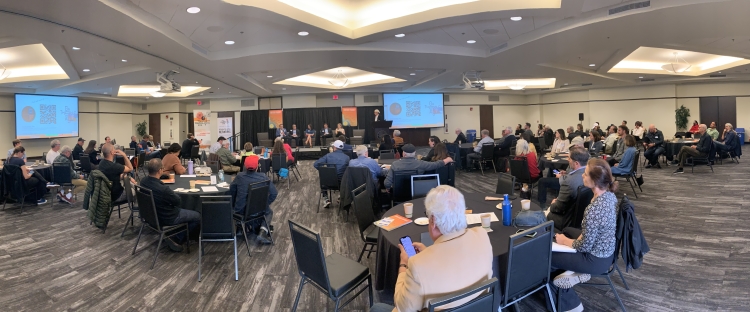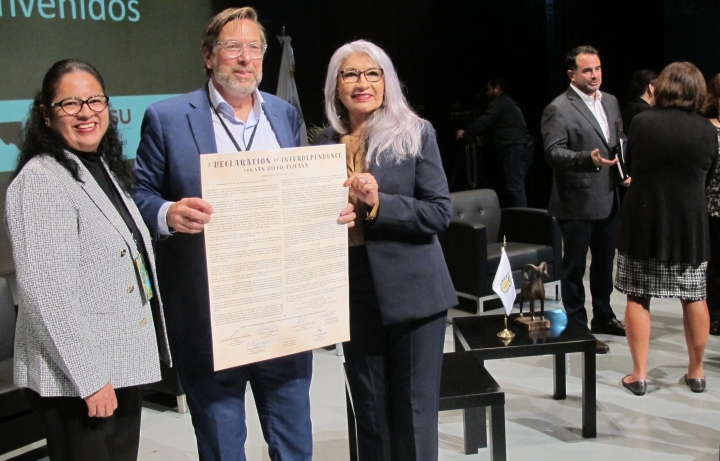On the border: Planning for a joint San Diego-Tijuana future

Fifty years ago, Bruce Appleyard’s father co-authored an aspirational blueprint for urban planning in the San Diego-Tijuana region called “Temporary Paradise?”
Now Appleyard, a city planning and urban design professor at San Diego State University, aims to reinvigorate “Temporary Paradise?” for a new generation.
Earlier this month, Appleyard hosted a workshop at SDSU where government officials, academic researchers and non-profit groups from both sides of the Cali-Baja border shared ideas on how to proceed with watershed management, binational planning, and construction of more housing in transit accessible communities.
“Temporary Paradise? was a pioneering plan that advocated for the San Diego/Tijuana border region to become a ‘zone of confluence’ that shares its economy, environment and cultures,” said Appleyard.
“Now my attention turns to revitalizing the dreams of “Temporary Paradise?” and working on an updated version, titled Temporary Paradise? Reimagined.”
Appleyard was in elementary school when his father, UC Berkeley Professor Donald Appleyard, brought the family to visit San Diego in 1974. He and co-author Kevin Lynch, both urban planning experts, received a $10,000 private grant to study solutions to traffic, sprawl, urban decay, and environmental threats facing San Diego during a period of rapid growth.
They produced a study with more than a dozen guideposts for smart growth before that phrase entered the lexicon. Though not an official government document, “Temporary Paradise?” influenced land-use planning across the region, especially its call to preserve San Diego’s canyons and hillsides from destruction for development.
“Temporary Paradise?” also was an early advocate for San Diego-Tijuana collaboration. It called Tijuana “an integral part of the San Diego landscape, and the rapid changes going on there must be managed by strong joint action.”
Appleyard’s father was killed by a drunk driver in 1982, and Lynch died a few years later. Since coming to SDSU, Appleyard has been the steward of “Temporary Paradise?” keeping alive its concepts that still resonate today.
At the workshop, Appleyard and Mexican partners discussed ideas for revising an updated version of “Temporary Paradise?”” More events are planned later this year, including workshops in Mexico.
Momentum for collaborative cross-border planning got a boost last year when San Diego and Tijuana were jointly named the World Design Capital 2024. It is the first time a two-city international border region has received the designation.
World Design Capital is a global non-profit initiative highlighting design-led policies and innovations to improve quality of life. Through a series of events throughout 2024, including the SDSU “Temporary Paradise?” workshop, World Design Capital seeks to curate 19 projects of binational interest, said Dinorah Gonzalez, a professor and researcher who serves as co-lead, alongside Appleyard, for the Planning and Placemaking Team for World Design Capital San Diego-Tijuana 2024.
“One of these initiations is “Temporary Paradise?” and the revision of this emblematic document,” said Gonzalez. “We invite all these experts in their fields to think about how we can build green infrastructure? How can we think about housing in a binational manner? How do we think about transportation and restoring our shared ecosystem?”
With the tailwind from San Diego-Tijuana World Design events, Appleyard has reprinted the original “Temporary Paradise?” study in English and Spanish. He also led an effort to produce a Declaration of Interdependence for San Diego-Tijuana. It debuted at last fall’s RE:BORDER conference and has received more than 2,000 signatures.

Appleyard and co-investigators received a grant from the San Diego Foundation to develop a climate, watershed, and coastal resiliency education and action plan for the binational region. Appleyard also received the Public Impact Award from SDSU’s Division of Research and Innovation tied in part to the authorship and binational dissemination of the Declaration of Interdependence.
The $2,000 award will help with “Temporary Paradise?” reprints and provide seed money toward fundraising for the Appleyard/Lynch Sustainable Paradise Scholarship Fund.

